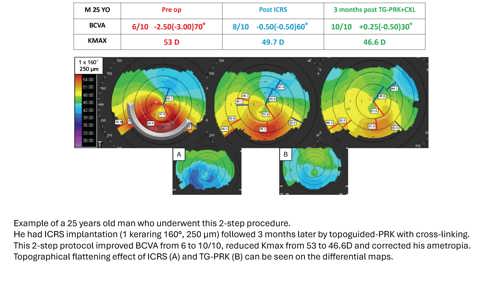Cornea, Corneal Therapeutics
Two-Step Procedure Shows Positive Results
Study reveals potentially useful prognostic factors in a large cohort of keratoconus patients.

A two-step surgical approach combining intracorneal ring segments (ICRS), then topography-guided PRK and cross-linking has proven a safe and effective treatment modality for a large cohort of patients with keratoconus, according to Olivier Prisant MD.
“This approach has already been published but with very small cohorts,” Dr Prisant said. “Whereas at the Clinique de la Vision in Paris, we have a lot of experience with this technique and have now treated 946 eyes with this protocol. Here, we present the three-month follow-up data for 686 eyes using this surgical protocol.”
Dr Prisant’s retrospective single-centre study was carried out at the Clinique de la Vision between 2009 and 2023, with the presenting surgeon operating on all eyes. All patients received either Keraring or Ferrara ring implants followed at least three months later by topography-guided PRK and cross-linking with another three months (minimum) of follow-up. Inclusion criteria were patients with grade 1, 2, or 3 keratoconus, pachymetry greater than 400 microns, and no previous eye surgery. Exclusion criteria included patients with ring explantation.

“In terms of the intracorneal rings, the arc length was primarily 160 degrees and either one or two rings, [which] were either standard or asymmetrical rings,” he said. “The surgical technique included marking at the horizontal axis and visual axis. The rings were inserted in a tunnel and performed using an IntraLase femtosecond laser at a depth of 75% minimal pachymetry.”
Topography-guided PRK was performed using WaveLight Pentacam Oculyzer and WaveLight EX500 Excimer Laser and cross-linking was performed using riboflavin for 10 minutes and exposure to 10 milliwatts of UVA for 9 minutes.
Dr Prisant said two-thirds of the patients were male. Best-corrected visual acuity significantly improved by an average of 1.0 lines after the ring implantation and 1.3 lines after the topography-guided PRK ablation.
“We achieved a mean improvement of 2.0 lines of BCVA after both treatments. Similarly positive outcomes were obtained for uncorrected visual acuity, which improved by a mean of 3.7 lines after both treatments,” he explained. “Mean spherical equivalent reduced by -3.5 D after three months, with most of the regularization achieved by the ring implantation. Refractive cylinder was also reduced by a mean of -3.3 D after both treatments, with the rings again responsible for most of the correction.”

Maximal keratometry was reduced by a mean of almost 7.0 D and most of the flattening effect was obtained with the ring surgery. The complication rate was very low with significant halos in 6 eyes (0.9%), and ring repositioning in 5 eyes (0.7%).
There is a clear rationale for performing the surgical sequence in the order described in the study, Dr Prisant said.
“The logic of the sequence is the ICRS will affect most of the corneal remodelling, which is tissue saving and reduces the need for photoablation. The topography-guided PRK acts as a fine-tuning effect to further improve the visual outcomes,” he said. “Although the aim of this study was to present short-term efficacy and safety results on a large cohort, another study [using] a subgroup of 154 eyes of our cohort with a minimum of three years of follow-up showed good long-term refractive and keratometric stability with this approach.”
The study also found that Kmax and keratoconus phenotypes may be important prognostic factors.
“We found a significant negative correlation between postoperative BCVA and preoperative Kmax, showing that Kmax may be an important prognostic factor. We also studied keratoconus phenotype as a prognostic factor and found decentred keratoconus treated with one 160-degree ring were the eyes that improved the most in terms of BCVA,” he concluded.
Dr Prisant presented at EuCornea 2024 in Paris.

Olivier Prisant MD is an ophthalmologist in private practice in Paris, France. oprisant@gmail.com